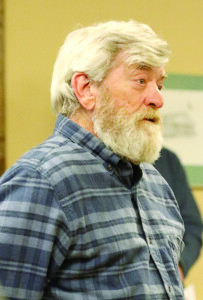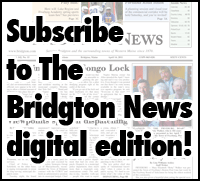Harrison gains more time to study educational options
By Wayne E. Rivet
Staff Writer
HARRISON — Harrison is no longer on the clock to decide whether to remain a member of SAD 17 or seek other educational options.
Wendy Gallant, co-chair of the Harrison Educational Options Committee (HEOC), reported to the Select Board last Thursday that the selection process for a new consolidated elementary school site will not occur until next winter, January or February.
“I can tell you from speaking with Heather Manchester (SAD 17 Superintendent of Schools) was that the urgency for us to make some decisions, have a straw poll, have a vote in June, all of that, has been taken off the table,” Gallant said. “The urgency has gone away... That pressure is off us, which is really good for us to hear.”
Originally, the SAD 17 expected to pick a site by August, pushing Harrison to figure out its next step — either stay in SAD 17 and see its elementary school closed or withdraw from the district, operate its own school system thus keeping Harrison Elementary open and contract for middle school and high school students to attend either SAD 17 or other MS/HS such as Lake Region or Fryeburg Academy. Creating a charter school is not possible since the state is at its limit of 10.
Meeting weekly, the HEOC has compiled information with the focus to present to Harrison citizens their educational options. Gallant noted the group has spoken with Superintendent Manchester, as well as SAD 61 Superintendent Al Smith (who said at this time the district could accept Harrison students) and an attorney.
The group requested current figures regarding Harrison’s debt owed to SAD 17, as well as if Harrison joins the consolidated school (its price tag estimated at $80 million), what happens to the Harrison Elementary building? The group was told if SAD 17 has no use for the building, it would be offered to the town. Harrison would assume any debt on the school building.
When asked, “What’s the condition of the elementary school right now?” the answer was “it depends on who you ask about that.”
“It’s habitable. Our kids are there.”
When the school was evaluated as part of the district’s consolidation idea to build a new elementary school, HES received a failing grade due to its lack of fire suppression (sprinkler system, which when the school was built, it was not a requirement).
Speaking for HEOC chairman Mike Guiffre, Gallant noted a public hearing had been scheduled to reveal some of the group’s findings, but now that site selection has been pushed back by SAD 17 (word has it the district is looking at property along the Route 117 corridor around the Pikes Hill area), the group will instead create a report and make it available via a newsletter and website. The survey had about 200 responders, about 10% of Harrison’s voting population. Of those 200-or-so, 70% were “non-parent folks,” Gallant said. Of the 30% considered parents of students, Gallant said based on the number of Harrison students, it “equates to about 70% of current parents did respond to the survey.” Harrison’s student population is pegged at about 205 (it was noted that Harrison’s student population has been “on a steady decline for 12 years straight,” and Harrison and Waterford schools are “about 50% utilized from their intended capacity”).
“That’s a really good number,” Gallant added. “What we’re finding as you go down through the survey results is that most people were not in favor of going to a consolidated school for fear of really losing our building and a sense of community.”
The HEOC plans to scale back meetings from weekly to monthly. Members plan to attend SAD 17 School Board and Building Committee meetings, “so we can keep our eyes and ears as to what’s happening on that end,” Gallant noted.
When asked if the HEOC might make recommendations at some point, Gallant responded, “I guess we could. We weren’t charged with that, to give a recommendation. We are charged to report on options.”
Selectman Nate Sessions questioned whether a vote on a $20 million bond to address SAD 17 maintenance is still scheduled for November? Sessions pointed out that if the bond passed and Harrison is still part of SAD 17, it would be responsible for a portion of that new debt. It’s a question that the group will search for an answer to.
Short Takes

Vote by Clicker — Rather than raising a hand to cast a “yes” or “no” vote at the annual town meeting, citizens will press their preferences using a “clicker.”
The town purchased 300 clickers, which include three buttons — yes, no and abstain — as well as numerical sequence and Harrison logo. When a vote is entered, the totals will appear on a screen. The new clickers will be tested prior to town meeting use.
“People will sign in and be assigned a number. We’ll give everyone some time and then we’ll say final answer (time to enter the vote). We’ll have a screen and it will show how many yes votes and no votes and abstentions,” said Maureen McAllister, town finance officer. “We won’t be counting hands.”
Neighboring Casco and Naples also utilize voting clickers. Harrison officials hope to work out an agreement with those towns that if additional clickers are needed, they could be borrowed.
“We saw two benefits. One is it would speed the process up. Two is privacy. When you vote, no one will know how you voted because there’s no standing or raising hands,” Select Board chairman Phil Devlin said. “I think the other advantage is that Harrison is not at the forefront of technology so we’re much more comfortable being the second or third one (town) in. There are a couple of sources of expertise, which we can probably arrange to have available to us if we need it.”
Different budget process coming? As the upcoming proposed budget takes shape with a workshop on Wednesday, April 2 at 4:30 p.m. (open to the public) and a public hearing set for April 9 at 6 p.m. at Harrison Elementary, Interim Town Manager Brad Plante plans to submit an article on the annual town meeting warrant to establish a permanent budget committee.
“There used to be a Budget Committee here years ago when I was here. I don’t know what happened to it. It just kind of went,” Plante said.
Plante said the committee will be appointed by the Select Board.
“My experience with an elected budget committee is that it’s a real struggle to get people to run,” Plante said.
Plante clarified that the budget committee would consist of five or seven citizens — “It’ll be totally independent, it’ll be separate” of the Select Board.
Plante then outlined how the process would work:
• The town manager and the finance director would present a draft budget to the budget committee.
• The budget committee then holds hearings, as well as hold discussions with the town manager and department heads. Budget numbers can be changed.
• The budget committee then presents the budget to the Select Board, which has final say as to what is presented to taxpayers. “The budget that goes forward to the town meeting is the Select Board’s budget,” Plante added. “It’s not the manager’s, it’s not the budget committee’s, it’s the Select Board’s budget. So, it’s a three-step process. Every year, it will work the same way.”
Warrant articles to be considered at town meeting are approved by the Select Board.
Next steps for Scribner’s Mill bridge? If the towns of Harrison and Otisfield decide against replacing the Scribner’s Mill bridge (it spans the Crooked River) — which has been closed and condemned by the Maine Department of Transportation — Trout Unlimited has a possible plan.
Jim Wescott of TU sent a letter to the town, as well as to Otisfield, on Feb. 14 to “discuss possible mutually beneficial changes at the site.”
“We recognize the bridge is co-owned by the two towns, and structural issues are so severe that it is beyond repair. We also recognize the cost replacement for the seldom traveled one-lane bridge may not be fiscally, a feasible option,” Wescott wrote. “We would like to offer a bridge and dam removal scenario where the towns benefit from hazardous abatement. The high river flow threat to Scribner’s Mill preservation site is greatly reduced, and aquatic organism passage to the Crooked River, especially the renowned landlocked salmon, is enhanced. We welcome the opportunity to present our thoughts and to hear yours.”
Interim Town Manager Brad Plante had a phone conversation with Wescott, who believes if the town towns agree to remove the bridge, funding can be secured to do that work at no cost to Harrison and Otisfield.
Selectman Nate Sessions believes the Scribner’s Mill Preservation Society utilizes the dam “to some extent” (a water wheel that provides power).
“I think we should involve Scribner’s Mill Preservation in any decision making that’s appropriate. The removal of the bridge seems likely appropriate, but the dam may be an inconvenience,” Sessions said.
Mike Garvey noted the local snowmobile club was looking to possibly save a portion of the bridge to enable crossing there.
When a meeting to discuss options is scheduled, all groups will be invited.
Volunteer needed for fee review — Since the topic of town fees came up during budget work, Interim Manager Brad Plante sought Select Board approval to allow him to recruit someone to do a “complete across the board study of all fees in the town…the whole nine yards.”
“We need to get a real feeling where we are at. Some of the fees are extremely low,” Plante said. “There are some facilities we’re not even charging a fee for. Before we make any decisions, we need to see the complete picture.”
Plante would like to find a volunteer — this would not be a paid position — with basic computer skills (able to use Excel and create spreadsheets).
While working in Sebago, Plante went through the same process. A Select Board member volunteered.
“There fees were all over the place,” he said.
Plante said the volunteer could also check to see what other towns charge for various fees. Ultimately, the Select Board sets the fees. Plante does not expect to have the fee review and/or fee recommendations until fall (he expects it will “take most of the summer”).
For more information, check the town website or contact Plante.

Planners to tackle Comp Plan — Harrison’s Comprehensive Plan needs to be update, and the Planning Board is willing to take on the project.
PB Chairman James Dayton said the project’s scope will be to update the existing plan and make changes where appropriate.
“The Comprehensive plan is a very well written document. The last time around, there were technical reasons why the state didn’t approve it. There are things in there that really haven’t changed,” Dayton said.
The update timeframe will likely be a year to 18 months, Dayton speculated.
Select Board Chairman Phil Devlin questioned how community engagement would be handled since the plan is a vision of what the community wants the future of Harrison to be.
“I want to be sensitive if there are people who would like to be actively involved,” he said.
“There will be plenty of opportunity,” Dayton answered.
PB Alternate Wendy Gallant hopes that once the plan is updated and approved by the state, it doesn’t sit on a shelf and collect dust. “We have to be able to execute that plan, otherwise, what’s the plan? I’m hoping that we’re prepared to do that,” she said.
The Select Board voted 3-0 to authorize planners to take the Comp Plan update lead.
Manager search update — Devlin gave a quick rundown on the town manager search: 1. The consultant has interviewed citizens, and plans to speak with town employees; 2. At the next Select Board meeting, officials will formally approve the Help Wanted advertisement and decide where it will be placed; 3. The consultant will screen preliminary list of candidates and passing along recommendations regarding applicants the board might like to consider.
“A final set of candidates will come to the board in the June/July timeframe,” Devlin said. “We’ll be trying to do a final selection once the two (Select) board members are elected in June.”
Pause mode for Downtown Revitalization — Is the time right to jumpstart downtown revitalization work or should Harrison remain in a pause mode?
Darryl Sterling, who is a grant writer and community development consultant, recapped revitalization work to date which included working with Wright Pierce Engineers in developing an action plan, holding public engagement workshops and formulating a list of priorities — items to tackle in Year 1 and Year 2 and then beyond.
The engineering firm submitted a planning study ($35,000) to the state, which is required to be in line for possible revitalization grant funding. Other studies anticipated include downtown parking and Main Street corridor study.
“That’s where we look at the geographic area of the downtown defined district, which will cover more sidewalks, sidewalk renewals, crossings, all of the traffic calming and streetscape, including streetlights,” Sterling said.
The planning study (estimated at $75,000) would be a 50/50 cost split with the Maine Department of Transportation.
“Then, that would lead to a larger project, which could be a million or two million to tackle major construction items to improve the downtown accessibility…to make the town more accessible, vehicular and pedestrian wise,” Sterling noted.
The ultimate question is whether to stay in pause mode or hit the reset button now.
“I don’t want to start over, but basically start fresh,” Devlin said. “I think we want to have a different committee with a different charter, so there will be more active participation. There were gaps in translations, things didn’t happen, so we’re correcting these things to move ahead.”
Wendy Gallant, who served on the Revitalization Committee, favored “hitting a pause, if not a reset button on this project.”
“I think a lot has changed. I think maybe we do need to kind of start over a little bit,” she said. “Communication was a problem.”
With the Select Board turning over updating of the Comp Plan to the Planning Board, Gallant suggested the revitalization remained paused, for now.
“The Comp Plan is the blueprint of your town. Everything comes from that, so it just seems wise for us to be working to complete the Comp Plan so we can really see the vision of what we all want going forward. So, maybe in a year from now, we would have a better idea…We’re on a good path. We have a good team going here. I really would like to see us not put the cart before the horse.”
Because the Select Board is short two members and staff vacancies exist in the town office, Plante felt a pause on revitalization until after town meeting might be a good move. The Select Board agreed.
Quick points — Watch your speed! County deputies issued 57 traffic tickets in February, which is almost two summonses per day.
• The town has hired a new administrative assistant, Catherine Wilcox.
• Work continues to correct a water issue at the new Public Works facility.
• The Long Lake boat ramp area needs retaining wall repair. Town officials were to meet with Maine Inland Fisheries and Wildlife this week.
• Grants and donations are being sought to replace/repair playground equipment at Crystal Lake Park and the RADR Complex. Two playground pieces, which were deemed “unserviceable and kind of dangerous,” were removed from RADR, Plante reported.
• Crosswalk flashing lights near Crystal Lake Park and the boat launch area on Long Lake will be installed (cost estimate, $14,175) in the next two to three weeks.
• Based on a report from engineers Wright Pierce, the town’s salt shed is in “tough shape.” Plante said the report did not contain estimates of the cost to either repair or completely replace the shed. Plante suggested the project be placed on the new Capital Improvement Plan list for the next fiscal year.
“It’s not in danger of collapsing, but it’s in pretty tough shape,” Plante said.

